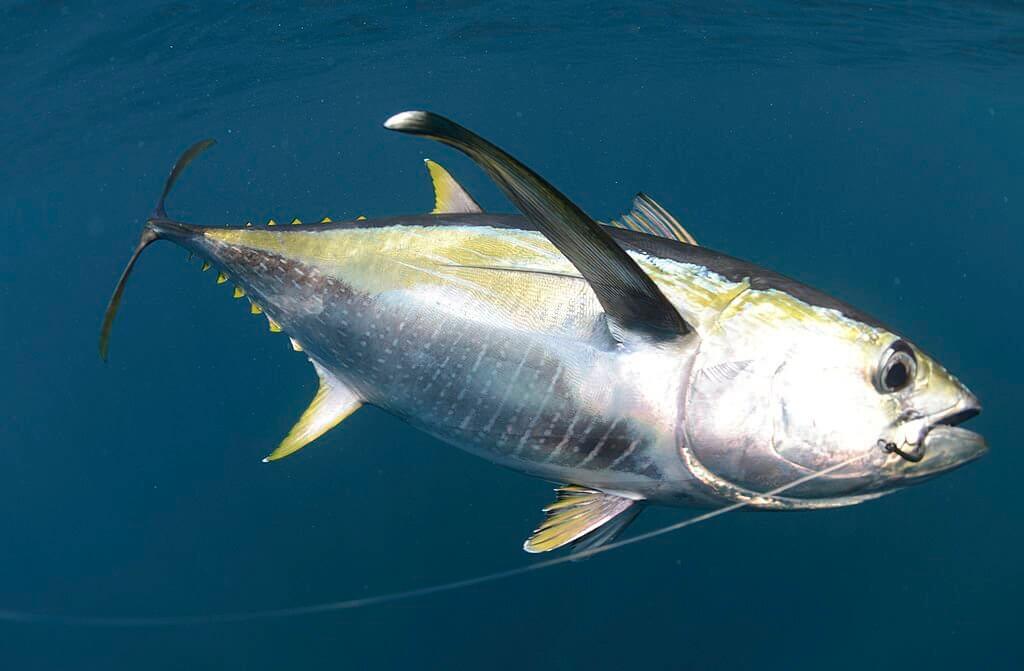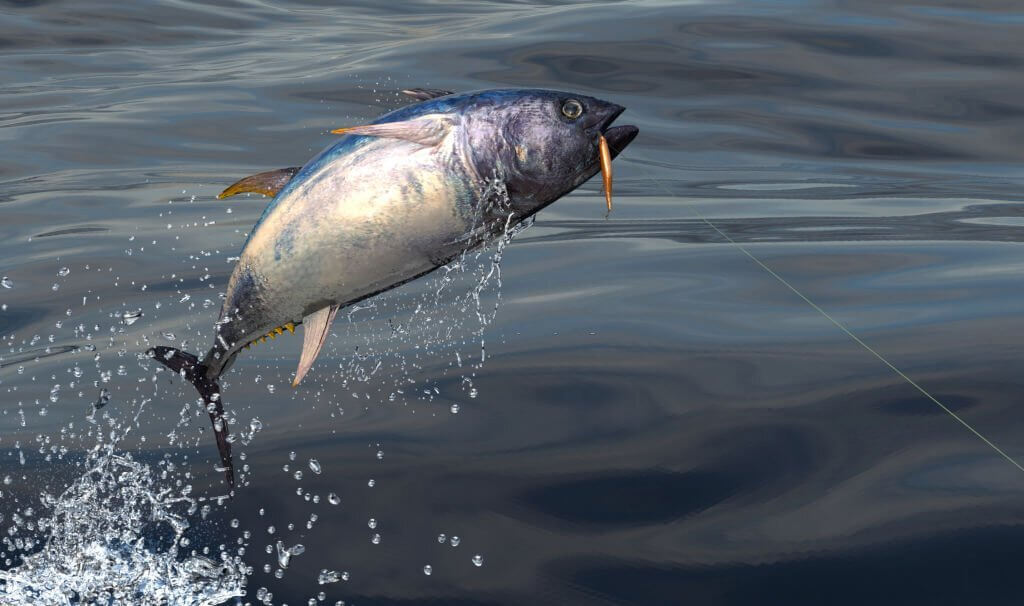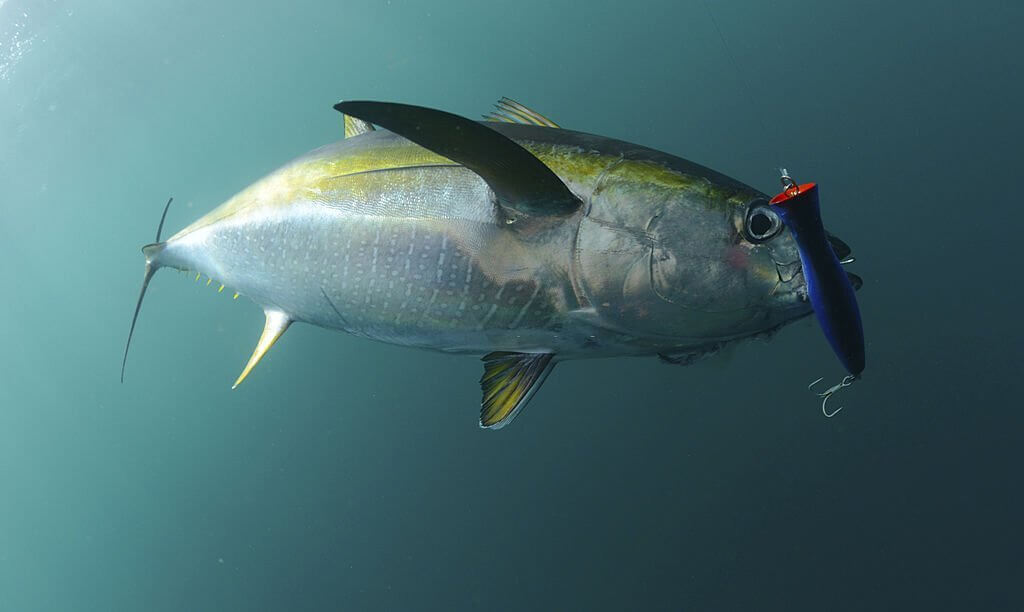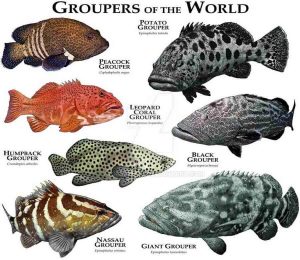Two of the most popular types of products on the market are Bluefin vs Yellowfin Tuna. These fish are all members of the tuna family. Most people enjoy these tunas since they can be prepared in a variety of ways and is simple to get done. It also has a delicious flavor.

Bluefin vs Yellowfin Tuna
Even though these two varieties of fish appear to be the same at a glance, there are significant differences between them.
This blog post will explain the differences between Bluefin vs Yellowfin Tuna.
We will make comparisons of their size, habitat, best fishing tactics, and even how they taste. Without further ado, let’s go straight to the meat of the discussion.
Similarities Bluefin vs Yellowfin Tuna
Because their colors fade after a long fight, it may be hard to tell the differences between Bluefin Tuna vs Yellowfin Tuna.
Both of them also come with a lot of protein, lipids, vitamins, and other minerals. But those are the end of their similarities.
Differences between Bluefin vs Yellowfin Tuna
It’s fun to watch the distinctive features between the two species. The first things to note are their appearance and size differing factors.
Appearance & Size
In terms of size, there’s a significant difference between the Bluefin vs Yellowfin Tuna. Bluefin tuna may grow to be more than 1,000 pounds in weight. On the other side, Yellowfin Tuna seldom grows to be more than 500 pounds.
The Yellowfin Tuna gets its name from a yellow lateral line above its pectoral fin and a vivid yellow second dorsal fin.

Tuna
The Bluefin Tuna, on the other hand, does not fall into this category. It features a silver underbelly with wavy lines and a second dorsal fin that is a combination of grey and yellow.
The tail of this Tuna differs from that of its counterpart in that it is dark blue rather than yellow and gray. This gives it a unique appearance.
Yellowfin Tuna have longer pectoral fins that frequently extend to the second dorsal fin. Blue Tuna’s fins are shorter and seldom reach the second dorsal fin.
When comparing tuna of different sizes, it is also possible to tell how tall or long their rear fins are. There are two kinds of tuna, and the easiest way to tell them apart is to consider all of the qualities we’ve discussed.
Habitat and Distribution – Bluefin vs Yellowfin Tuna
The two species that we compare turn out to have different habitats and distributions.
Bluefin Tuna habitat and distribution
Tunas are well known for traveling large distances to feed and breed. They prefer water temperatures ranging from 50 to 70 degrees Fahrenheit. The Atlantic Bluefin Tuna is the biggest of the particular tuna species, and it may be found from the east coast of North America to the Mediterranean Sea, and even up to Norway.
The schools from the Pacific Ocean are eaten by those who reside there. They must go a long distance for their lives. They may be found in considerable numbers in Papua New Guinea and the Philippines.
Yellowfin Tuna Habitat and distribution
Temperatures are the key to Yellowfin Tuna’s preferred habitat those of other tuna species. This variety of fish may be found off the shores of Hawaii, California, and the northwest coast of South America.
They may be found at water temperatures ranging from the mid-60s to the upper 70s Fahrenheit. Aside from Panama, Florida, and the whole Caribbean are the most frequent places for them. The schools of fish are also spending their time in the waters of northern South America, the Canary Islands, South Africa, and Western Australia.
How to catch
Catching the different types of Bluefin vs Yellowfin Tuna can be slightly challenging. As mentioned, the blue tunas weigh more than the latter. Therefore, the methods used by the anglers will also be different.
How to catch Bluefin Tuna
Prepare for a fishing excursion by ensuring that you have all of the necessary equipment. To catch sharks, use a 50-pound-capacity reel and a short, heavy-action rod.
On their reels, the anglers should utilize braided lines weighing 65 to 80 pounds. Bite leads weighing between 40 and 100 pounds are recommended. Before you put your lines in the water, double-check everything.

Catch Bluefin
Large-game lures, like 9-inch plugs and 12-ounce jigs, are available right immediately. Circular hooks ranging from 3/0 to 5/0 can be used in place of trebles and with any type of yarn.
Be prepared to lose more than 300 yards of fishing line before you can begin reeling in your catch.
Bluefin Tunas can swim for a short distance. Is that what you’re into? If this is the case, it will become hydrated and fight back even harder than before. Maintain the pressure to obtain a better catch.
Examine the guts of the first particular species to determine the type of bait to use. Select a color and size that complements the bait.
Allow the fish to run and weary before reeling it in.
It may be abundant in November, and they may remain until May depending on the weather. During tuna season, you may catch tuna up to ten miles from shore. Tuna may be caught in 100 feet of water between November and December when the tunas are growing larger.
The months of February and April are ideal for photographing these magnificent objects. The fish tuna rises to the surface at this time of year. They can be up to 50 kilometers off the shore. So, there are a lot of zones that you can invade with your angler pals.
How to catch Yellowfin Tuna
To be as effective as possible in the last stretch of the season, you must constantly switch up your locations, approaches, and gear.
In the summer, when it is hot outside, people may discover a lot of Yellowfin Tuna near the coast and go fishing. Because tuna are difficult to spot and have excellent vision, chunking, jigging, and kite fishing are the best methods for catching them.

Catch Yellowfin Tuna
The greatest time to go tuna trolling in the mid-Atlantic is early in the season when there are more fish. When fishing for shy species like ballyhoo using 50-pound gear and spreader bars, you may also be prepared for huge fish that come on your line. There is no question that you can reduce your terminal equipment.
To create a chum line, first put up your drift or anchor your boat. Then, every 30 seconds, you toss portions of chopped bait into the water. If you give this delightful treat to hungry tuna, they will follow your hook baits to eat them. When you fish the way you normally do, there are several strategies to capture more fish.
Because your bait is moving slowly on the piece, the tuna can tell that something is amiss. So, to conceal the hook, insert it within the bait. Your baits should not be aimed away from the chunks. To ensure that the pieces float, they should be fed at the same rate as the baits.
Even if they don’t come up every year, a good fishing report might help you discover them. The grill and sushi knife are both ready. When the dinner invitation arrives, you will be able to check your gear and readiness before going to the catching zone.
Taste
Sushi fans are well known that Bluefin and Yellowfin Tuna have rather unique tastes.
Not all foodies know well the exact difference if they are just occasional consumers. But for the avid fans of tuna sushi, there’s a chance that the chef or restaurant staff explain to you the huge differences between the two species of tuna.
Experts suggest that most people are unaware of how much effort goes into making tuna taste excellent. Some tuna parts may be more fatty than others and employed for different purposes. There are a lot of possibilities that consumers can enjoy depending on the type of cuts of the tuna.

Yellowfin tuna taste
The finest sushi is produced using o-toro fine experience, the most pricey and largest slice of tuna.
However, Akami is the most efficient and cost-effective alternative to complete jobs swiftly.
In most sushi restaurants, A Bluefin Tuna may command a higher price. It could be difficult then to decide the winner of Bluefin vs Yellowfin Tuna.
The tuna is prized for its flavor and scarcity. This dark-red fish is served as sushi in many high-end restaurants, but it is also grilled or fried. It tends to be more pricey and exclusive.
It was previously said that tuna leads many folks to want to enjoy various parts of the fish.
While the previous tuna is scarce, Yellowfin Tuna, which is reddish-orange and contains less fat than Bluefin, is more widespread. It’s called Ahi tuna, and it’s a popular sushi option at lower-priced eateries, it can be created in a variety of ways. Although it is possible to use the o-toro experience on ahi tuna, many consumers praise the Bluefin ones.
Nutritional value
These tunas also have different nutritional values. Let’s find out below.
Yellowfin Tuna’s nutritional value
According to research, if you want to reduce your risk of heart disease, you should consume more tuna fish, which has a high concentration of omega-3s. This type of tuna also contains the health properties that you need to stay healthy. Increasing omega-3 diet has been related in multiple studies to lower risks of cardiovascular disease, including heart attacks. Add this into your diet and you will reap the benefits.
Bluefin Tuna’s nutritional value
This fish contains protein, selenium, vitamin B6, and omega-3 fatty acids, all of which are beneficial to your health.
It has also been shown that taking omega-3 supplements can aid with anxiety, sadness, and attention deficit hyperactivity disorder symptoms (ADHD).
Bluefin tuna contains a high concentration of vitamin B12, a water-soluble vitamin with several health advantages. It is critical to have vitamin B12 to produce red blood cells and maintain the health of your brain system. B vitamins have an immediate impact on how your body uses energy, how well your organs function, and how much energy you have.
The Southern type of Tuna is considered a “superfood” due to its high selenium content. Even if you’ve never heard of selenium, it’s essential for your health. Selenium supplementation has been related to improved memory and verbal fluency in Alzheimer’s sufferers and those who aren’t as bright as they once were.
People who consume a lot of tuna have improved cognitive ability and better overall health.
Cost
Yellowfin meat tends to be less expensive than Bluefin meat, regardless of how it is prepared.
The average price per kilo for this Yellowfin Tuna fish (whole, from the Pacific Ocean) is expected to be $2.30 in 2020. In 2019, the identical item cost $2.30.
A pound of Bluefin Tuna may cost $20 to $40 if you reside on the East Coast. Depending on where you acquire it, Bluefin from Japan might cost more than $200 per pound.
Sustainability – Bluefin vs Yellowfin Tuna
Many tuna species have been overfished, but not all. Skipjack and Yellowfin Tuna are two popular canned tuna varieties. Both the Western and Central Pacific Oceans feature a large number of these two species (WCPO). It is also present in the Indian Ocean, which is beneficial to the ecology.
The Bluefin Tuna is frequently used as a symbol of overfishing’s detrimental impacts. If you want to eat sashimi at your favorite sushi restaurant, there’s good news. It’s an excellent idea to acquire Atlantic tuna from a US fishery. All in all, always use your discretion whenever you purchase tuna products from the market.
Conclusions
Bluefin subspecies have been overfished to extinction because so many people want to consume their excellent meat. Because of these discoveries, the IUCN has added Atlantic Tuna to its endangered and critically endangered lists.
It is usually preferable to purchase tuna from a supplier that does not pollute the environment.
They have several distinctions, and you can now identify them apart. As you’ve read the article above, you are more familiar with Bluefin vs Yellowfin Tuna. Therefore, we hope you will have an informative decision when you’re about to catch them.
Maybe you also like:
- Albacore vs Yellowfin Tuna – Quick Guide
- Black Cod vs Cod – Which one is good for your health?














